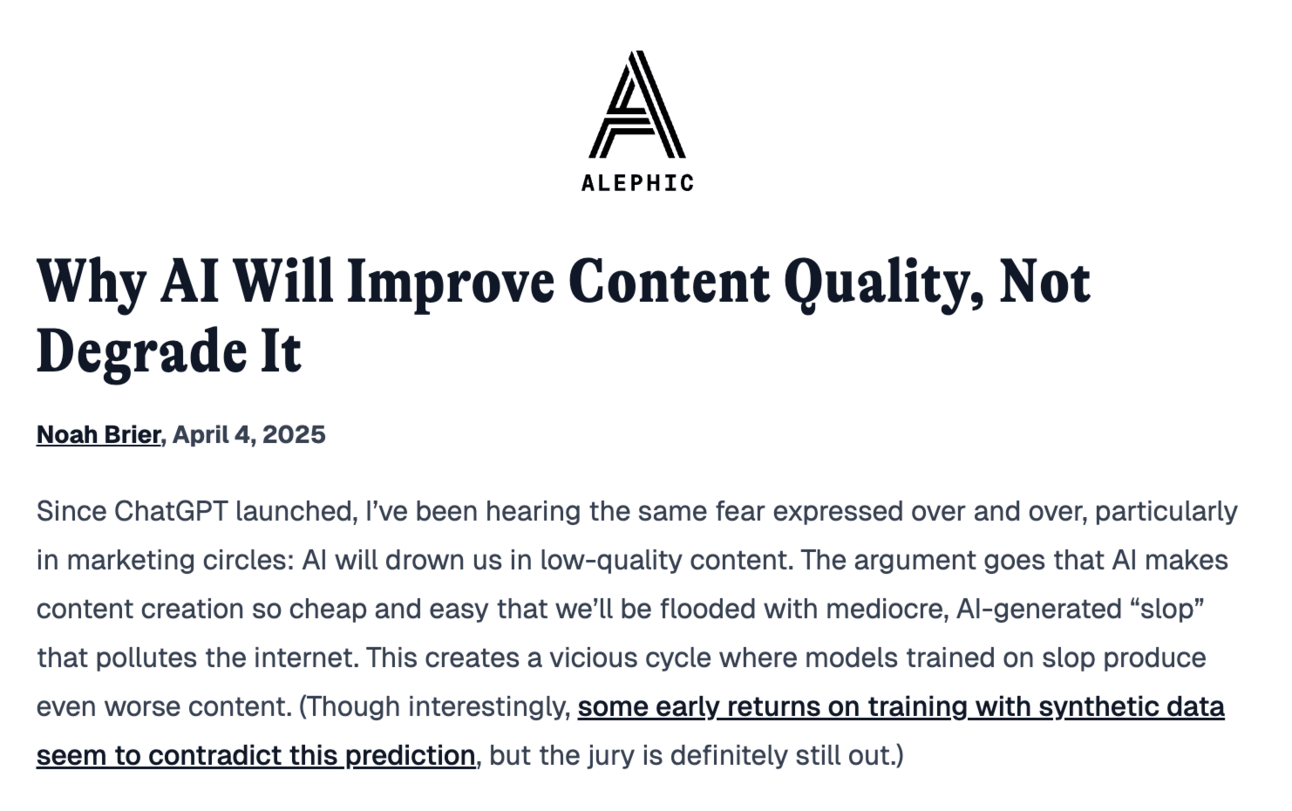- Build Signals
- Posts
- But Why Is Nobody Vibe-Coding? - #2
But Why Is Nobody Vibe-Coding? - #2
We’ve got the tools. We’ve got the speed. So why are so many teams still building like it’s 2019?

We’re sitting on the best AI dev tools we’ve ever had.
React apps in minutes, real-time backends spun up with one click, custom agents, no-code front-ends, and even dev mode if you need it.
And yet…
Most teams are still treating AI like a side project.
Still hand-coding flows. Still “learning React” like it’s a prerequisite to ship.
This week’s Build Signals is about the gap — between what AI makes possible and how product teams are actually working.
We’ll look at:
🧪 A real-time demo of building an AI tutor in under an hour
✍️ Why writing content for AI is becoming a competitive edge
🧠 Designing for AI agents: Microsoft’s UX principles for the next interface
🚀 And a reminder that designer founders are still one of the most underrated forces in tech
…plus much more!
If you’re still shipping like it’s 2019, this one might sting a little. But it’s also your blueprint for catching up.
Let’s dive in 👇
🗓️ Upcoming Events
I’m hosting a free event next week exploring how AI is reshaping UX - and what smart product teams are doing about it.
🧠 What we’ll cover:
Where AI is creating new UX challenges (and opportunities)
What “good UX” looks like in AI-native products
How to rethink your workflows, assumptions, and career path
🗓 Wednesday, April 23rd
📍 Online
If you’re a CTO, PM, or strategist wondering how to stay ahead of the curve — this is for you.
🔗 Signals This Week
Dave Haigh, an interaction designer working in UK government services, asked a smart question: How easy is it to integrate AI into the GOV.UK Prototype Kit?
The Kit is used across government teams to prototype accessible services, and Dave wanted to see if he could bring modern AI capabilities into a tool that’s usually focused on speed, simplicity, and standards. Spoiler: he pulled it off — and it’s surprisingly useful.
My take:
This is exactly the kind of bottom-up innovation that makes public sector tools better
The fact that a designer could experiment like this shows how far we’ve come with AI dev accessibility
It’s also a great reminder: AI isn’t just for consumer apps — it can (and should) be tested inside legacy, standards-driven systems
GOV.UK is often held up as a model of clarity and user-first design — seeing it start to absorb AI capabilities is a big signal
It also quietly challenges other teams: If they’re doing this in government, what’s your excuse?
Noah Brier argues that AI won’t flood the internet with low-quality junk — it’ll actually make great content more important than ever. As AI agents become the middle layer between brand and customer, the incentive shifts: not to crank out slop, but to produce authoritative content that LLMs respect and reference.
My take:
This flips the panic: the risk isn’t content collapse, it’s being invisible to the models
Brands won’t just write for people — they’ll write for GPT, Claude, and their retrieval pipelines
AI behaves like a rational consumer — it indexes quality, structure, and clarity over emotional appeal
“Content for humans” and “content for AI” will split — smart teams will learn to do both
There’s a land grab happening now: become a trusted node in the model’s world view
If you’re not creating content that AI can find, understand, and trust, you’re building for an audience that no longer controls the buying journey.
In a recent office hours session, the Lovable team set themselves a challenge: build a fully functional, AI-powered Spanish tutor app in under an hour.
They didn’t just talk theory — they built it live. Using Supabase for backend and auth, React for the front-end, and AI for the experience layer, they showed just how accessible building real AI apps has become.
This was the kickoff to their Zero to Launch series, and honestly, it’s one of the most practical demos I’ve seen in a while.
My take:
AI dev isn’t just faster now — it’s approachable for designers, PMs, and non-devs too
This kind of demo shows how much scaffolding is now abstracted — and how product folks can prototype smarter
Supabase + AI + React = the new MVP stack for builders
Even if you’re not building an AI tutor, the thinking and flow here is reusable
This is the skill stack that separates thinkers from tinkerers in the AI space
AI without thoughtful design is just capability waiting to be ignored. The teams that will win aren’t the ones with the best model. They’re the ones who make that model feel seamless to use and give real value.
Ben Blumenrose from Designer Fund makes a compelling case: we’re entering another historic moment for designer-led startups. This time though, it’s AI that’s creating the opportunity.
As the foundational tech in AI starts to level off, product experience and design will become the key differentiators. This moment mirrors what we saw with mobile and SaaS. So why aren’t more designers stepping up to lead?
My take:
This is exactly the kind of inflection point where design becomes strategy
If AI levels the playing field technically, design becomes the moat
The excuses (“I’m not a business person,” “I don’t know sales”) are solvable — not structural
We don’t need every designer to be a founder — but the best ones could be
It’s not just a moment for designers — it’s a moment for investors, platforms, and operators to spot and back them
We don’t have a pipeline problem — we have a permission problem. If you’re a designer who’s even considering building, now’s the time to stop asking and start doing.
Checkout Design Founders and sign up to their newsletter. It’s going to be great.
Microsoft just released a set of principles for designing agentic experiences — UX guidelines for AI systems that don’t just respond, but reason, adapt, and act. These aren’t your typical chatbot flows. These are deeply integrated systems that need to earn trust, operate across time, and disappear when needed. This piece is essential reading if you’re building anything with AI that goes beyond a prompt bar.
The framework spans:
Space (how agents connect to people, platforms, and context)
Time (how they learn from the past, act in the present, and adapt over time)
Core (how trust, control, and transparency shape every interaction)
My take:
This is the clearest blueprint I’ve seen yet for designing AI agents as products, not just features
UX now has to account for memory, multimodal inputs, and invisibility — this is a new design paradigm
“Nudging more than notifying” is chef’s kiss - great agents don’t just ping, they participate
Transparency isn’t optional - users will need to trust that agents act on their behalf, not behind their backs
Most importantly: this pushes design teams to stop thinking in screens, and start thinking in systems over time
Agent UX is the new frontier — and these principles will age well. If you’re designing for chat, voice, multimodal or behind-the-scenes automation, this is your next UX toolkit.
💡 Build On This
"The key to success is failure… Success is made of 99 percent failure."
Andrew Wilkinson shared this on X.
Here’s the takeaway: Don’t fear failure — use it. Every test that doesn’t work still teaches you something. And if you’re failing, it means you’re trying, experimenting, building.
Here’s how to make that mindset work for your business:
Turn failures into feedback loops
Write a quick “what we learned” memo after every experiment — even if it flopped. The team will move faster with shared understanding.
Ship before it’s perfect
Done > perfect. The market is your best validator. Stop polishing in isolation.
Celebrate reps, not just results
Track how many new things you’ve tested, launched, or shipped this month. Velocity builds momentum.
Reframe what failing means
If a landing page didn’t convert, great — now you know what doesn’t resonate. You’re closer to clarity.
Document why something failed
Don’t just shrug it off. Capture the “why” so future-you (or your team) doesn’t repeat the same trap.
📌 The truth? Most people aren’t failing because they’re trying too much.
They’re failing because they’re not trying at all.
📬 From the Feed
📅 Free Event Next Week: UX + AI — Sign up today!
Linear has now introduced Agents: “With Linear for Agents, we’re introducing a platform for a new model of collaboration. One where human and artificial intelligence work side by side. Agents become teammates: contributing, co-creating, and accelerating the development process.” More here
Build Product Tours That Don't Suck - superb article by Molly Norris Walker and as Molly says “Companies like Notion, Slack, and Figma prove that well-designed product tours can significantly boost customer success and activation rates.” Read here.
📲 If you liked this and spend most of your time on LinkedIn, then consider giving me a follow @ross-chapman.
🔚 Until next week…
Found this useful? Please forward it to a product-minded friend.
Want more like this every week? Subscribe here →



